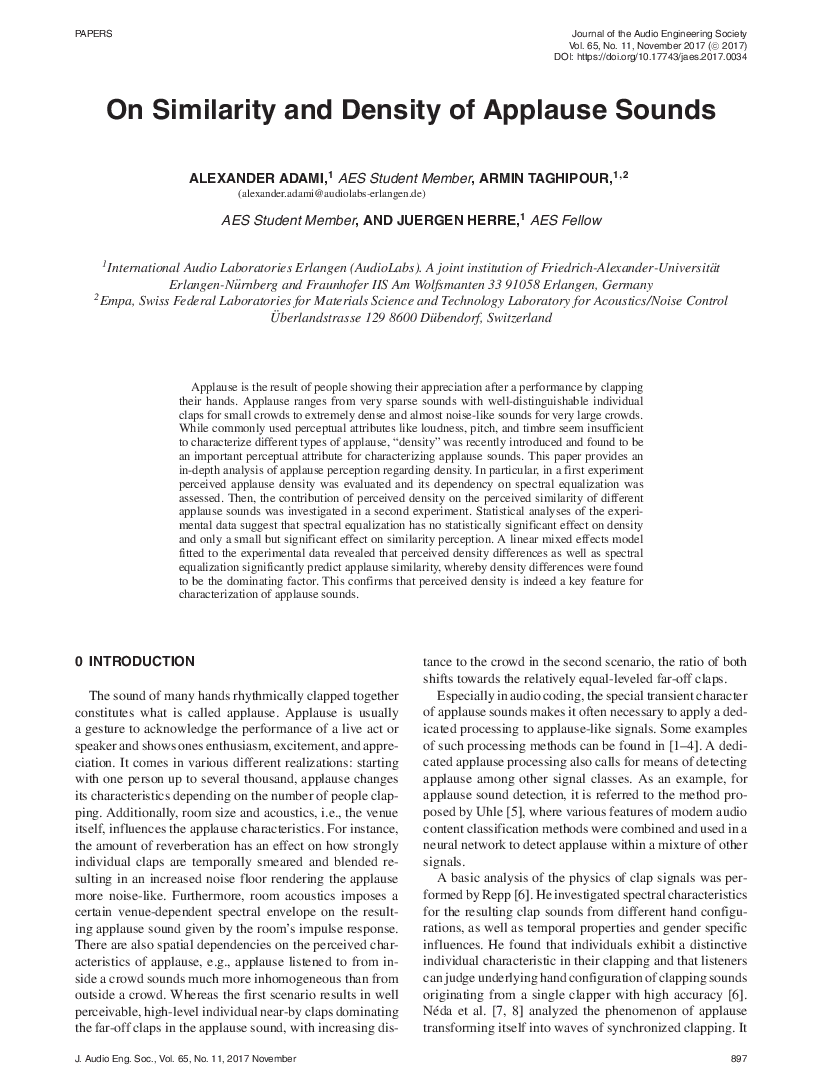Home / Publications / E-library page
You are currently logged in as an
Institutional Subscriber.
If you would like to logout,
please click on the button below.
Home / Publications / E-library page
Only AES members and Institutional Journal Subscribers can download
With applause an audience expresses its enthusiasm and appreciation; it is therefore a vital part of live performances and thus live recordings. Applause sounds range from very sparse sounds with easily distinguishable individual claps in small crowds to extremely dense and almost noise-like sounds in very large crowds. Commonly used perceptual attributes such as loudness, pitch, and timbre seem insufficient to characterize different types of applause, while “density,” which was recently introduced, is an important perceptual attribute for characterizing applause-like sounds. In this paper, the perceptual properties of applause sounds are investigated with a focus on how spectral equalization affects their perception. Two experiments are presented: the extent to which spectral equalization influences the perception of density and the impact of spectral equalization on the perceived similarity of applause sounds with different densities. Additionally, the data of both experiments were jointly evaluated to explore the effect of perceived density and spectral equalization on the perceived similarity of applause sounds. A statistical analysis of the experimental data suggests that spectral equalization has no statistically significant effect on density and only a small but significant effect on similarity. A linear mixed effects model fitted to the experimental data revealed that perceived density differences as well as spectral equalization significantly predict applause similarity. Density differences were found to be the dominating factor. Finally, the results appear applicable to other impulsive sounds with a high rate of transient events.
Author (s): Adami, Alexander; Taghipour, Armin; Herre, Jürgen
Affiliation:
International Audio Laboratories Erlangen (AudioLabs). A joint institution of Friedrich-Alexander-Universität Erlangen-Nürnberg and Fraunhofer IIS, Erlangen, Germany; Empa, Swiss Federal Laboratories for Materials Science and Technology Laboratory for Acoustics / Noise Control, Dübendorf, Switzerland
(See document for exact affiliation information.)
Publication Date:
2017-11-06
Import into BibTeX
Permalink: https://aes2.org/publications/elibrary-page/?id=19359
(937KB)
Click to purchase paper as a non-member or login as an AES member. If your company or school subscribes to the E-Library then switch to the institutional version. If you are not an AES member Join the AES. If you need to check your member status, login to the Member Portal.

Adami, Alexander; Taghipour, Armin; Herre, Jürgen; 2017; On Similarity and Density of Applause Sounds [PDF]; International Audio Laboratories Erlangen (AudioLabs). A joint institution of Friedrich-Alexander-Universität Erlangen-Nürnberg and Fraunhofer IIS, Erlangen, Germany; Empa, Swiss Federal Laboratories for Materials Science and Technology Laboratory for Acoustics / Noise Control, Dübendorf, Switzerland; Paper ; Available from: https://aes2.org/publications/elibrary-page/?id=19359
Adami, Alexander; Taghipour, Armin; Herre, Jürgen; On Similarity and Density of Applause Sounds [PDF]; International Audio Laboratories Erlangen (AudioLabs). A joint institution of Friedrich-Alexander-Universität Erlangen-Nürnberg and Fraunhofer IIS, Erlangen, Germany; Empa, Swiss Federal Laboratories for Materials Science and Technology Laboratory for Acoustics / Noise Control, Dübendorf, Switzerland; Paper ; 2017 Available: https://aes2.org/publications/elibrary-page/?id=19359